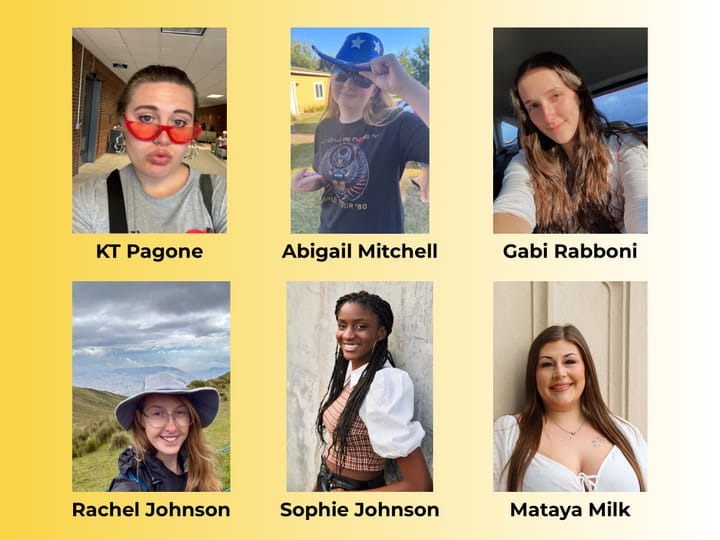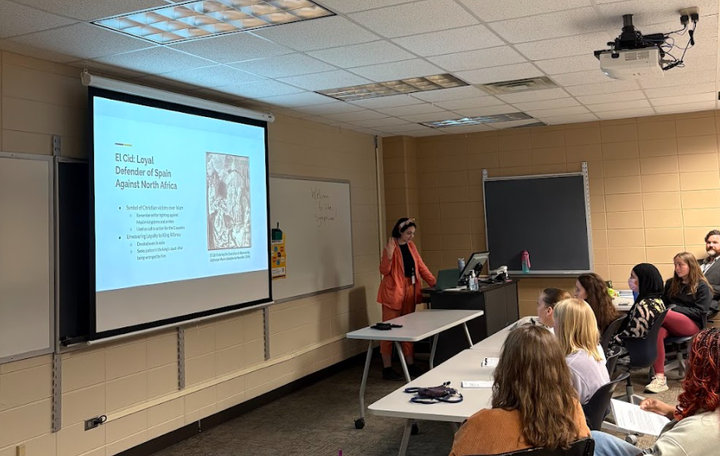Rain or Shine: Campus moves outdoors
Professor Julie Swanstrom presents a lesson about her First Year Seminar theme “Making Monsters Out of the Other” in the stone Outdoor Classroom. Photo by Camryn Hay.
Camping chairs, beach towels, blankets and good jackets replace pencils and notebooks as essential school supplies this fall.
Informed about the safety open-air locations bring, some professors have chosen to teach outside this semester, and the benefits seem to go further than disease mitigation.
“There are some elements of this that are working so well, especially for my upper division classes, that I might consider making being outside an important part of it,” Swanstrom said. “We talk to each other more than what we do when we’re sitting at desks.”
Centers for Disease Control and Prevention research says the coronavirus spreads mainly through respiratory droplets from nearby people.
“There’s a debate about whether or not it’s spread in the air, but it’s definitely higher risk if you’re in an enclosed environment,” Swanstrom, who was a part of the academic working group for the Viking Flex Plan, said.
So, being in wide open spaces provides an extra level of safety.
Classrooms of Stone and Grass
Make no mistake, Augie’s campus holds more than one outdoor classroom.
The morning sun is soft in the shady “Humanities Forest” where Julie Swanstrom’s Religion 233 class sprawls six feet apart.
Swanstrom teaches all three of her classes in different campus nooks.
Her First Year Seminar (FYS) class does use the stone Outdoor Classroom, but her Medical Humanities students show up with blankets at 8:30 a.m. to the picnic tables beneath the Moses statue. She provides the chairs, blankets and beach towels for student seating.
“Until I had good reason to be a roving professor carrying a camping chair, it wasn’t something that I was anticipating,” Swanstrom said.
Professor David O’Hara has taught class in the grassy midpoint between the chapel and the library, where folding camp chairs are available as well as three Adirondack chairs that he built.
He notes that quiet spaces make it easy to teach outdoors. As he and his class explored outdoor spaces to meet, he asked, “How does it feel to be out here?”
Assistant professor of anthropology K.C. Carlson teaches in the grassy area outside Archaeology Lab 2 in the morning and in the greenspace by Old Main in the afternoon.
With her FYS class, she’s taken excursions to Heritage Park, and for writing time on campus, they’ll sprawl out on blankets or prop up with a backpack pillow.
“I was just looking around [thinking] this is better,” Carlson said. “I mean everybody was comfortable. They were getting work done.”
A Lab for the Humanities
Swanstrom, O’Hara and Carlson agree that added distractions outdoors, like squirrels, are not all bad.
O’Hara remembers staring out the window during class in his childhood and recalls it actually helped jog his memory about the teacher’s lesson.
“I like being able to bring students outdoors, just to the other side of the window,” O’Hara said. “If that’s where we’re looking, let’s go there.”
O’Hara noted that students can remember information better when they are physically involved in learning, which is exactly what an outdoor classroom does.
“Our memory is often visually associated and associated with our other senses as well,” O’Hara said.
The environment acts as a lab for his environmental philosophy class where he can use an unusual weather day as a lesson about climate change.
“Whether we’re reading a work of environmental philosophy or reading Shakespeare, being able to do it outdoors, the outdoors becomes the laboratory where we experience some of the things that we’re talking about,” O’Hara said.
Swanstrom plans to walk students to the two Moses statues on campus when they discuss why both are depicted with horns.
Carlson is used to teaching some lessons outside, like surveys and digs. She says field school takes place entirely outdoors.
Weather and Tech Challenges
In that regard, Carlson and O’Hara say that unless the weather is dangerous, like a tornado or thunderstorm, students should show up to class with an umbrella and coat prepared to experience class during a drizzle.
“I know from running field schools and travel courses, it’s hard to focus when you’re cold, but it actually doesn’t take much to be warm,” Carlson said. “It just takes a little bit of planning.”
Both are prepared to provide extra clothing and materials to students who need it. O’Hara started collecting padded Amazon envelopes for students to sit on without being directly on the cold, wet ground. Carlson plans to get hand warmers for her students.
While Swanstrom doesn’t plan to stay out in rainy or snowy weather, she’s grateful for the extra safety being outdoors will provide to her and her students for now.
The professors note they are prepared to adjust circumstances based on student concerns. If one student asks O’Hara to have class indoors for a specific reason, he’ll move back into the classroom.
Without powerpoints and projector screens to lean on, each outdoor professor has had to adjust their teaching methods to include less traditional note taking and more group discussion.
He purchased a gray crane-arm with a three-pronged base to hold his phone. The apparatus makes it possible for him to Zoom virtual students into class and stably adjust the camera to face the speaker.
An external microphone and bluetooth speaker also help online and in-person students hear each other in the discussions.
Carlson has also been Zooming kids into class discussions from her phone and disinfecting it before and after passing it to the speaker.
“I want the students to feel comfortable and safe going into quarantine and not feeling like they’re going to miss something,” Carlson said. “So that was a big thing for me, bringing Zoom on my phone out.”
Swanstrom has adjusted the structure of her lesson plans to accommodate the lack of Wi-Fi outside the classroom.
She has students view all the readings and videos before class so they can apply it in discussions.
Classroom adaptations and lesson plan alterations primarily decrease the risk of disease transmission, but at the same time, students benefit from discussion and memory-making that’s unique to sunny classrooms.
“It’s like everybody is getting their vitamin D,” Carlson said. “They’re a little bit more in touch with what’s going on around them.”



